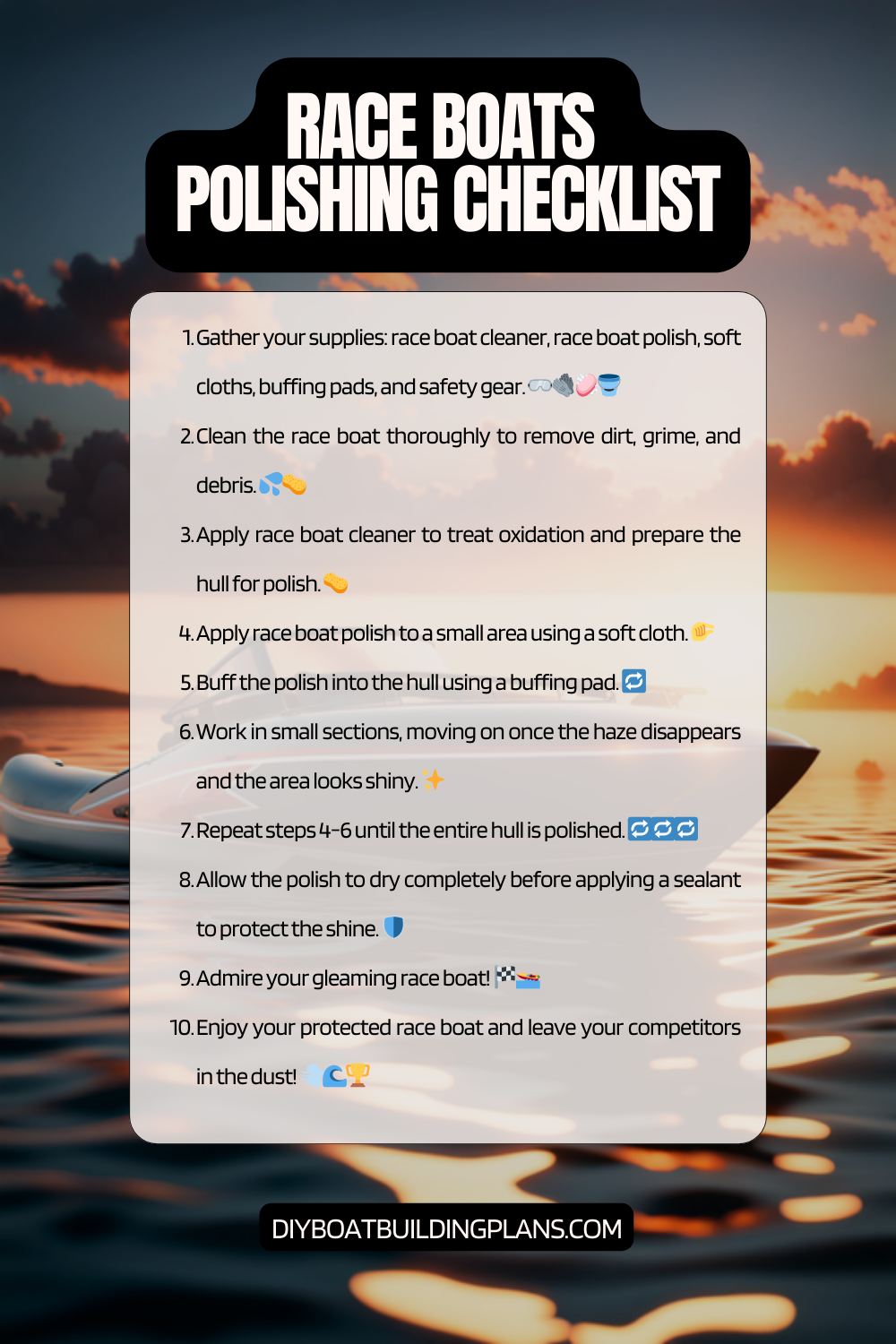Overview of Race Boat Polishing Tips
Race boat polishing is the process of restoring and maintaining the shine and smoothness of a race boat’s exterior surfaces. It involves using specialized polishing products and techniques to remove imperfections, such as oxidation, scratches, and swirl marks, and create a high-gloss finish. Maintaining a polished boat is crucial for racing as it not only enhances the aesthetics but also improves the boat’s speed and performance on the water.
Key Takeaways
- Polishing is crucial for maintaining the appearance and performance of race boats.
- Choosing the right polishing products and preparing the boat properly are key to achieving a high-quality finish.
- A step-by-step guide can help ensure a thorough and effective polishing process.
- Different types of boat surfaces require different polishing techniques, and hard-to-reach areas may require special attention.
- Proper maintenance and avoiding common mistakes can help maintain the shine of a polished race boat, while safety precautions should always be taken during the polishing process.

Importance of Polishing for Race Boats
One of the primary reasons why race boat polishing is essential is because it can significantly improve the speed and performance of the boat. A polished surface reduces drag, allowing the boat to glide through the water more efficiently. By eliminating imperfections, such as scratches or oxidation, the boat can achieve higher speeds and better maneuverability, giving racers a competitive edge.
In addition to performance benefits, polishing also provides protection against environmental factors. The constant exposure to sun, saltwater, and other elements can cause damage to a race boat’s exterior surfaces over time. Polishing creates a protective barrier that helps prevent fading, corrosion, and other forms of deterioration. This not only extends the lifespan of the boat but also reduces maintenance costs in the long run.
Furthermore, aesthetics play a crucial role in racing competitions. A polished boat not only looks impressive but also reflects professionalism and attention to detail. It can catch the judges’ eyes and make a lasting impression on spectators. In a sport where every advantage counts, having a well-polished race boat can contribute to an overall positive impression and potentially influence the outcome of a race.
Choosing the Right Polishing Products
When it comes to choosing the right polishing products for a race boat, there are several factors to consider. Firstly, it is important to understand the different types of polishes available and their specific uses. There are compounds designed for heavy-duty restoration work, while others are formulated for regular maintenance and shine enhancement. Understanding the specific needs of the boat’s surfaces will help determine the appropriate polish to use.
Another factor to consider is the compatibility of the polish with the boat’s materials. Different boats may have different surface compositions, such as fiberglass, metal, or gelcoat. Each material requires a specific type of polish to achieve optimal results. It is crucial to select a polish that is safe and effective for the boat’s particular surface.
Additionally, it is important to consider the ease of application and removal of the polish. Some polishes require multiple steps and additional equipment, such as buffing pads or machines, while others can be applied and removed by hand. Depending on personal preference and available resources, choosing a polish that fits one’s capabilities and convenience is essential.
Preparing the Boat for Polishing
| Task | Time Required | Materials Needed | Tools Required |
|---|---|---|---|
| Cleaning the Boat | 2 hours | Boat soap, water, scrub brush, sponge | Bucket, hose |
| Sanding the Boat | 4 hours | Sandpaper (various grits), sanding block, masking tape | Orbital sander, dust mask, safety glasses |
| Applying Compound | 3 hours | Compound, applicator pad, microfiber towel | Buffer, extension cord |
| Polishing the Boat | 2 hours | Polish, applicator pad, microfiber towel | Buffer, extension cord |
Before starting the polishing process, it is crucial to properly prepare the boat’s surfaces. This involves cleaning the boat thoroughly to remove any dirt, grime, or debris that may interfere with the polishing process. Using a mild detergent and water, scrubbing the boat’s surfaces with a soft brush or sponge will help remove any surface contaminants.
In addition to cleaning, it may be necessary to remove any old wax or polish residue from previous applications. This can be done using a specialized wax remover or solvent. It is important to follow the manufacturer’s instructions and take necessary precautions when using these products.
If there are deeper imperfections on the boat’s surfaces, such as scratches or oxidation, sanding and buffing may be required. This involves using sandpaper or a buffing compound to smooth out the imperfections before proceeding with the polishing process. It is important to use caution and follow proper techniques to avoid causing further damage to the boat.
Step-by-Step Guide to Polishing a Race Boat
Once the boat has been properly prepared, it is time to begin the polishing process. Here is a step-by-step guide to help achieve a polished finish:
1. Applying polish to the boat: Start by applying a small amount of polish onto a clean, soft cloth or applicator pad. Work in small sections, applying the polish in circular motions. Make sure to evenly distribute the polish and avoid applying too much pressure.
2. Buffing the boat: After applying the polish, use a buffing pad or machine to work the polish into the boat’s surfaces. Move the buffer in overlapping motions, ensuring that the polish is evenly spread and any imperfections are being addressed. Take care not to stay in one spot for too long, as this can cause heat buildup and damage the surface.
3. Removing excess polish: Once the polishing process is complete, use a clean microfiber cloth to remove any excess polish from the boat’s surfaces. This will help reveal the high-gloss finish and ensure a smooth, even appearance.
Tips for Polishing Different Types of Boat Surfaces
Different boat surfaces require specific polishing techniques to achieve optimal results. Here are some tips for polishing different types of boat surfaces:
– Fiberglass: When polishing fiberglass surfaces, it is important to use a non-abrasive polish specifically designed for fiberglass. Avoid using harsh compounds or abrasive materials that can damage the gelcoat layer. Work in small sections and apply gentle pressure to achieve a smooth, glossy finish.
– Metal: Polishing metal surfaces, such as stainless steel or aluminum, requires specialized metal polishes. These polishes are formulated to remove oxidation and restore shine without scratching or damaging the metal. Use a soft cloth or applicator pad to apply the polish and work in small circular motions.
– Gelcoat: Gelcoat surfaces are commonly found on fiberglass boats and require specific care during the polishing process. It is important to use a non-abrasive gelcoat polish that is safe for the surface. Apply the polish using a soft cloth or applicator pad and work in small sections. Take care not to apply excessive pressure, as this can cause damage to the gelcoat layer.
Polishing Techniques for Hard-to-Reach Areas
Polishing hard-to-reach areas of a race boat can be challenging but not impossible. Here are some techniques to help polish those tight corners and edges:
– Using a small buffer: Invest in a small handheld buffer or polisher that can reach into narrow spaces. These tools are designed to provide precision polishing and can be maneuvered easily in hard-to-reach areas.
– Hand polishing: In areas where a buffer or polisher cannot reach, hand polishing can be an effective technique. Apply a small amount of polish onto a soft cloth or applicator pad and work the polish into the area using circular motions. Take care to apply even pressure and avoid excessive rubbing.
– Tips for polishing tight corners and edges: When polishing tight corners or edges, use a smaller applicator pad or cloth to ensure better control and precision. Apply the polish in small amounts and work in gentle circular motions. Take your time and be patient to achieve the desired results.
Maintaining the Shine of a Polished Race Boat
Once the race boat has been polished, it is important to maintain its shine to ensure long-lasting results. Regular cleaning and maintenance are key to preserving the polished finish. Here are some tips for maintaining the shine of a polished race boat:
– Regular cleaning: Wash the boat regularly with mild detergent and water to remove dirt, salt, and other contaminants that can dull the shine. Avoid using abrasive cleaners or brushes that can scratch the surface.
– Protective coatings: Consider applying a protective coating, such as wax or sealant, after polishing. These coatings provide an additional layer of protection against UV rays, saltwater, and other environmental factors.
– Touching up scratches and blemishes: Keep an eye out for any scratches or blemishes that may occur during racing or regular use. Address these issues promptly by using touch-up polishes or compounds to maintain the overall appearance of the boat.
Common Mistakes to Avoid When Polishing a Race Boat
While polishing a race boat, it is important to avoid common mistakes that can compromise the results. Here are some mistakes to avoid:
– Over-polishing: Applying too much pressure or spending excessive time in one area can lead to over-polishing, which can damage the boat’s surfaces. Follow the manufacturer’s instructions and use gentle, even pressure during the polishing process.
– Using the wrong products: Using the wrong type of polish or abrasive materials can cause irreversible damage to the boat’s surfaces. Always use products specifically designed for the boat’s materials and follow the recommended guidelines.
– Not properly preparing the boat: Skipping or rushing through the preparation process can result in poor polishing results. Take the time to clean, remove old wax, and address any imperfections before proceeding with the polishing process.
Download over 500 Boat Plans. Click on the link below.
-->Click Here<--
Polishing Safety Precautions
When polishing a race boat, it is important to prioritize safety. Here are some safety precautions to consider:
– Protective gear: Wear gloves and safety glasses to protect your hands and eyes from chemicals and debris during the polishing process.
– Proper ventilation: Ensure that you are working in a well-ventilated area to avoid inhaling fumes from polishes or solvents.
– Avoiding flammable materials: Keep flammable materials, such as gasoline or open flames, away from the polishing area to prevent accidents.
Race Boat Polishing Checklist

Conclusion – Race Boat Polishing Tips
In conclusion, race boat polishing is a crucial aspect of maintaining a competitive edge in racing competitions. It not only improves speed and performance but also provides protection against environmental factors and enhances aesthetics. By choosing the right polishing products, properly preparing the boat, and following a step-by-step guide, one can achieve a polished finish that will impress judges and spectators alike.
It is important to consider the specific needs of different boat surfaces and employ appropriate polishing techniques. Regular maintenance and proper care will help maintain the shine of a polished race boat, while avoiding common mistakes and prioritizing safety precautions will ensure a successful polishing experience. With these tips and advice in mind, racers can confidently prepare their boats for the next thrilling race, knowing that their polished exteriors will contribute to their overall performance on the water.
FAQs – Race Boat Polishing Tips
What is race boat polishing?
Race boat polishing is the process of cleaning and shining the exterior of a race boat to improve its appearance and performance.
Why is race boat polishing important?
Race boat polishing is important because it helps to reduce drag and improve the boat’s speed. It also helps to protect the boat’s exterior from damage caused by exposure to saltwater, UV rays, and other environmental factors.
What are some tips for race boat polishing?
Some tips for race boat polishing include using a high-quality polishing compound, using a microfiber cloth or foam pad to apply the compound, working in small sections, and using a rotary buffer to achieve a high-gloss finish.
What types of polishing compounds are best for race boats?
The best types of polishing compounds for race boats are those that are specifically designed for use on fiberglass and gelcoat surfaces. These compounds should be formulated to remove oxidation, stains, and other imperfections while leaving a high-gloss finish.
How often should race boats be polished?
Race boats should be polished at least once a year to maintain their appearance and performance. However, boats that are used frequently or exposed to harsh environmental conditions may need to be polished more often.
Can race boat polishing be done by amateurs?
Yes, race boat polishing can be done by amateurs, but it requires some knowledge and skill to achieve a professional-looking finish. It is important to follow the manufacturer’s instructions for the polishing compound and equipment, and to work carefully and methodically to avoid damaging the boat’s exterior.



